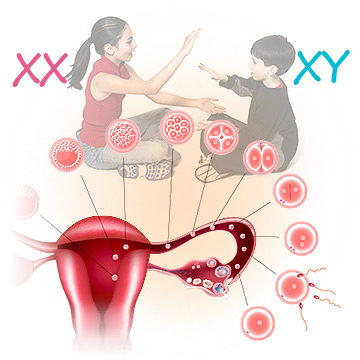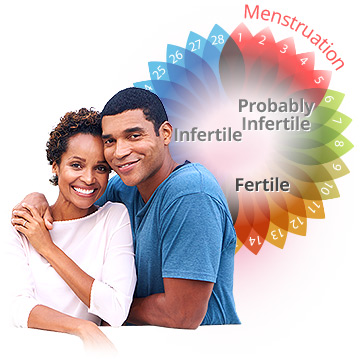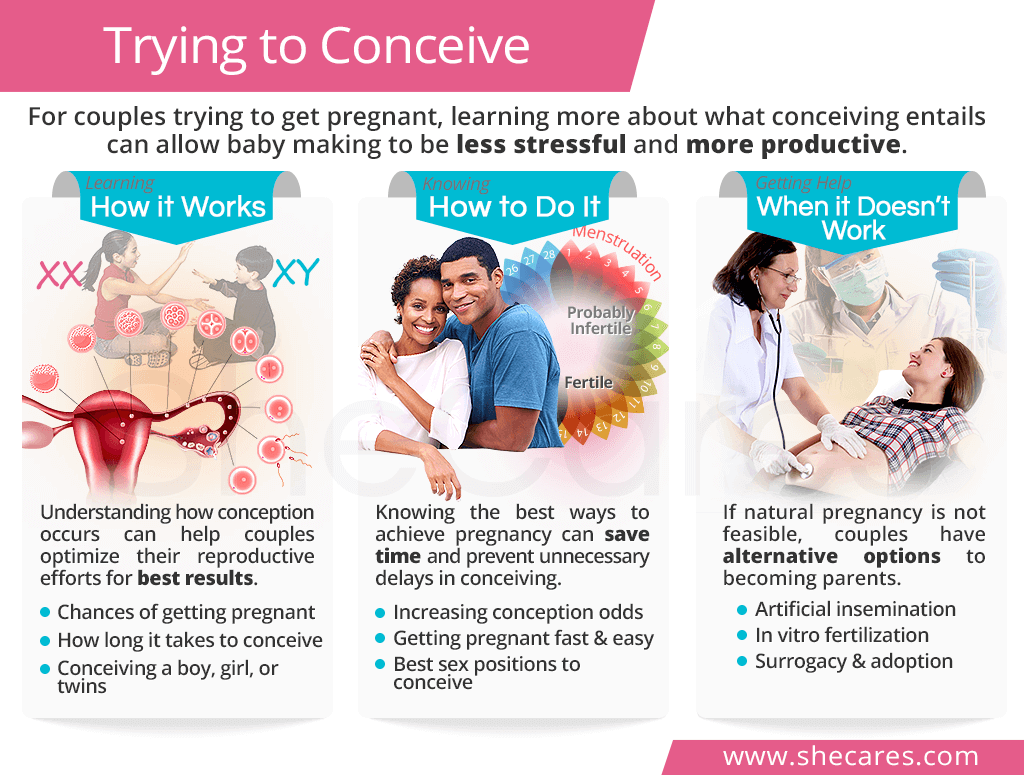Learning How Baby Conception Works

In biology, conception occurs when sperm fertilizes the egg. Nevertheless, there are a number of important reproductive events surrounding it that can determine whether conception takes place.
Events around Conception
Because the events before and after conception are key for a pregnancy to occur, their knowledge can help couples optimize their conceiving efforts more adequately.
Ovulation. For an egg to be fertilized, it has to be released from the ovary into the fallopian tube. This release, called ovulation, typically occurs in the middle of a woman's menstrual cycle. The egg remains in the tube for 12 to 24 hours, which is the only time it can be fertilized.1
Fertilization. If the sperm enters the reproductive tract while the egg is in the fallopian tube, it can fertilize it, marking the beginning of human development, referred to as conception.
Implantation. Once fertilized, the egg will continue traveling down the fallopian tube towards the uterus to implant itself in its lining. Implantation occurs about six to ten days after fertilization.
Once implanted, the egg will undergo numerous developmental changes, from being a zygote to becoming a fetus for the next 40 weeks until birth.
Chances of Conceiving
One of the most frequent questions couples trying for a baby ask is how long it takes to get pregnant. Generally, a couple has up to a 25% chance of a successful conception in any given cycle. Thus, it can take up to a year of having regular, unprotected sex for a healthy couple to conceive.2
A woman's fertility mainly depends on her ovarian reserve, a lifetime supply of eggs stored in her ovaries for potential fertilization. Because ovarian reserve gradually declines with a woman's age, it is one of the most important determinants of her chances of getting pregnant, among other factors, such as health conditions before getting pregnant, paternal age, or intercourse timing.
Pregnancy Spacing
Pregnancy spacing is an important concept to consider when trying to conceive. It is concerned with how soon after giving birth is best for a woman to get pregnant again.
As research has shown, ideal spacing involves waiting 18-23 months between pregnancies. Conceiving a baby sooner than 18 months has been associated with pregnancy complications, like premature birth or low birth weight. It also puts mothers' lives in danger due to a higher risk of bleeding and postpartum depression.
Conceiving a Boy, Girl, or Twins
Future parents often research best ways to conceive a boy or a girl as well as how to have twins. Genetically speaking, it is impossible to pre-determine the baby's gender naturally. Men's sperm carry Y chromosomes that decide on the baby's sex, and the mechanism is due to pure chance.
The only way to increase the odds of having a baby of a specific sex is through gender selection, a technique used with in vitro fertilization (IVF). Although originally designed to screen the embryos for genetic disorders prior to transferring them into the uterus, it can enable parents to choose their baby's gender.
Actively Trying to Get Pregnant

Ideally, a couple about to start trying to conceive should have been preparing to get pregnant for a few months, which generally consists of learning how to estimate ovulation and boosting fertility to better prepare for parenthood.
However, whether a couple has dedicated some time to pre-pregnancy planning or decided about parenthood only recently, they now share the same goal: getting pregnant fast and easy. Luckily, there are a number of steps to take to increase chances of getting pregnant.
Getting off Birth Control
Although stopping birth control might be an obvious step when trying for a baby, learning about how long after stopping birth control can a woman get pregnant is crucial for optimal conception efforts.
Most contraceptive methods stop a woman's ovulation to prevent unplanned pregnancies. Depending on the birth control used, it might take time for ovulation to return and fertility to be fully restored. Generally, ovulation restarts within the first month after getting off most birth control methods. However, others might take longer.
Knowing your Fertile Window
Being able to estimate a woman's most fertile days within the menstrual cycle is essential for conceiving a baby fast. It can be easily done with ovulation tests, like checking cervical mucus, and various predictor tools, like ovulation calculators or trackers.
Typically, there are six fertile days within a woman's menstrual cycle. Timing intercourse within that fertile window gives the highest chances of conceiving.
Ovulation day, lasting for 12 to 24 hours, during which the egg is in the fallopian tube
Three to five days before ovulation since the sperm can survive in the reproductive tract for up to five days
Having Frequent Sex
Besides knowing when to have sex, having sex frequently is the second most important thing to baby conception.
Women are advised to have unprotected sex every day or at least every other day during their fertile window.
For women with irregular periods or irregular ovulation, having sex every two-three days throughout the cycle will ensure that they hit their fertile days.
Couples trying for a baby are often on the lookout for best sex positions to get pregnant. Although there is no scientific evidence that certain positions improve the likelihood of conceiving, it is generally believed that those that allow for deep penetration and give the sperm a faster way to reach the egg are best for baby-making, including the missionary or doggie style position.
Getting Help Conceiving a Baby

Couples actively trying to get pregnant are told to keep trying for 12 months if a woman is younger than 35 years old, or for six months if she is 35 or older. If conception does not occur, proper evaluations for infertility are necessary to pinpoint the underlying cause.
Infertility
Infertility is said to affect up to 15% of couples in their reproductive age. Female fertility problems are most commonly rooted in ovulation problems, while male infertility tends to revolve around the sperm, including its production, transport, or function.
Fortunately, most couples are able to restore their fertility and go on to have healthy pregnancies with proper infertility treatment, which might include the following:
Healthy lifestyle changes, such as a nutritious diet, regular exercise, and alternative therapies for optimal weight, hormonal balance, and stress relief, all of which can boost fertility.
Alternative medicine consisting of phytoestrogenic supplements like black cohosh or dong quai and hormone-regulating supplements, like Macafem, both of which can help resolve the hormonal roots of infertility.
Conventional medicine comprising of fertility pills and injections to induce ovulation or fertility surgery to remove anatomical abnormalities preventing healthy conception.
Options for Infertile Partners
When natural pregnancy is not feasible, there are a number of alternative options for couples trying for a baby. They include the following:
Assisted reproductive technologies (ARTs) include a variety of procedures designed to assist couples in getting pregnant. Most common ARTs include artificial insemination (AI) or IVF with a woman's own eggs or through egg or embryo donation.
Surrogacy is when a person other than the partners agrees to get pregnant, carry the pregnancy to term, and give the child to the couple after birth. It can be done with the father's sperm and the surrogate's eggs or entirely with a couple's genetic material through IVF.
Adoption is an option for partners who cannot have biological children. It consists of legally becoming a parent to a child that is not a couple's own.
Conclusions
Many couples do not realize that it is actually a challenging task to get pregnant until they begin trying to conceive. A woman's short fertility window, which was once seen as an advantage when pregnancy was not desired, can quickly become the number one enemy for aspiring parents as months go by without conceiving. As such, it is easy for anxiety and stress to sneak in, often taking a toll on a couple's relationship and further compromising their reproductive efforts. This is why understanding how the reproductive system works, realizing that it can take time to get pregnant, and knowing the best ways to get pregnant can help partners approach baby conception with more focused and less stressed attitudes for ultimate success.
Sources
- American Pregnancy Association. (2018). Getting Pregnant. Retrieved January 15, 2019 from http://americanpregnancy.org/getting-pregnant-ebook/p7M7O0q1c71703C/gettingpregnant.pdf
- American Pregnancy Association. (2018). How to Get Pregnant Naturally. Retrieved January 15, 2019 from http://americanpregnancy.org/naturally/get-pregnant-naturally/
- Better Health Channel. (n.d.). Conceiving a baby. Retrieved January 15, 2019 from https://www.betterhealth.vic.gov.au/health/healthyliving/Conceiving-a-baby
- CDC. (2018). Planning for Pregnancy. Retrieved January 15, 2019 from https://www.cdc.gov/preconception/planning.html
- Cleveland Clinic. (n.d.). Pregnancy: Ovulation, Conception & Getting Pregnant. Retrieved January 15, 2019 from https://my.clevelandclinic.org/health/articles/11585-pregnancy-ovulation-conception--getting-pregnant
- David, S. & Blakeway, L. (2009). Making babies. New York, NY: Little, Brown and Company.
- Health Direct. (2018). Getting pregnant. Retrieved January 15, 2019 from https://www.healthdirect.gov.au/getting-pregnant
- Mayo Clinic. (2011). Guide to a Healthy Pregnancy. Boston, MA: De Capo Press.
- Mayo Clinic. (2016). How to get pregnant. Retrieved January 15, 2019 from https://www.mayoclinic.org/healthy-lifestyle/getting-pregnant/in-depth/how-to-get-pregnant/art-20047611
- National Health System. (2018). Trying to get pregnant. Retrieved January 15, 2019 from https://www.nhs.uk/conditions/pregnancy-and-baby/getting-pregnant/
- Office on Women's Health. (2018). Trying to conceive. Retrieved January 15, 2019 from https://www.womenshealth.gov/pregnancy/you-get-pregnant/trying-conceive
- Twenge, J. (2016). The Impatient Woman's Guide to Getting Pregnant. New York, NY: Atria Paperback.
- University of Michigan. (2018). How Pregnancy (Conception) Occurs. Retrieved January 15, 2019 from https://www.uofmhealth.org/health-library/tw9234
Footnotes:
- Mayo Clinic. (2022). What ovulation signs can I look out for if I'm trying to conceive? Retrieved September 15, 2022 from https://www.mayoclinic.org/healthy-lifestyle/getting-pregnant/expert-answers/ovulation-signs/faq-20058000
- NHS. (2021). How long does it usually take to get pregnant? Retrieved September 15, 2022 from https://www.nhs.uk/pregnancy/trying-for-a-baby/how-long-it-takes-to-get-pregnant/


